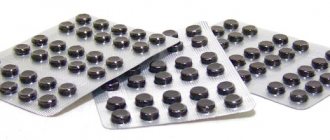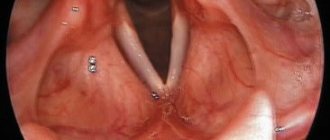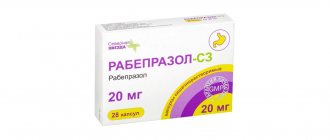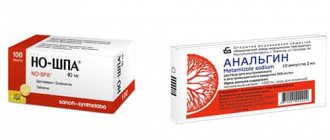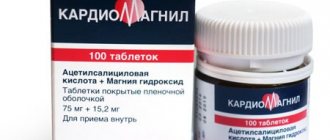Gastal as a chemical drug
The drug Gastal is a buffer antacid. Its main purpose is to reduce the acidity of gastric juice to a normal level. Hydrochloric acid is neutralized quite quickly for a long time, and accordingly, the discomfort that it provoked (heartburn, abdominal pain) disappears.
Antacids are medications that are intended for the treatment of acid-dependent gastrointestinal pathologies. They neutralize hydrochloric acid, an important component of gastric juice. As a result, irritation of the digestive mucosa stops. Buffer antacids do not dissolve in water, are practically not absorbed into the blood, but absorb hydrochloric acid, converting it into another substance (insoluble salts).
The active ingredients of Gastal are two components:
- Aluminum hydroxide-magnesium carbonate gel (in the amount of 450 mg per tablet). It absorbs hydrochloric acid, while simultaneously activating the protective and regenerative process on the surface of the stomach. Through associated compounds with phosphates and carbonates, insoluble salts are formed; subsequently, they are simply removed from the body naturally.
- Magnesium hydroxide (300 mg). It has a neutralizing effect on hydrochloric acid, and also on bile. At the same time, a mild laxative effect appears. Due to chemical reactions, the substance, similar to aluminum, turns into insoluble salts.
Due to the fact that the active substances act in a complex, the risk of unwanted reactions observed with each component separately is reduced (constipation after consuming aluminum compounds, diarrhea after magnesium).
The drug has two active ingredients - aluminum hydroxide-magnesium carbonate gel and magnesium hydroxide.
The antacid also contains auxiliary components: namely mannitol and lactose monohydrate, magnesium stearate and sorbitol, talc, etc.
The drug acts almost immediately (within a few minutes), the effect lasts for about two hours. The product is excreted in the form of insoluble salts in the stool.
The antacid is available in the form of tablets intended for resorption. They are quite large, round, whitish in color, and have a smooth surface. There is an option without flavoring, as well as with cherry or mint flavor.
Gastal tablets are quite large, round, white.
Video: principle of action of antacids, including Gastal
Gastal
Gastal ®
(lat.
Gastal ®
) is an antacid drug intended for the treatment of diseases of the digestive tract, the mechanism of action of which is based on the neutralization of gastric acid. According to the pharmacological index, gastal belongs to antacids and adsorbents. For ATC - to the group of antacids, subgroup “Antacids in combination with other drugs”, code A02AX.
Composition of the drug Gastal
Active substances:
one tablet of gastal contains 450 mg of hydrotalcite and 300 mg of magnesium hydroxide.
Excipients
(for the drug in tablets): mannitol, sorbitol, lactose, corn starch, sodium cyclamate, sodium saccharinate, talc, magnesium stearate, peppermint flavor.
Gastal release forms
- pills
- cherry lozenges
- mint lozenges
Pharmacological action of Gastal
Gastal is a combined antacid drug for oral administration.
Reduces the increased acidity of gastric juice to a physiological level and eliminates dyspeptic disorders by neutralizing excess hydrochloric acid in the stomach. The magnesium hydroxide and aluminum hydroxide included in gastal provide rapid and long-term neutralization, causing an antacid effect. The antacid effect of the drug appears immediately after taking Gastal tablets and lasts about 2 hours. 1 tablet of gastal neutralizes about 21.5 mmol of hydrochloric acid. Gastal inhibits the action of pepsin, lysolecithin and bile acids, thus also eliminating gastric dysfunction. Gastal, in addition to its antacid effect, activates protective and regenerative mechanisms in the gastric mucosa. The cytoprotective effect caused by aluminum ions includes stimulation of the secretion of mucus and sodium bicarbonate in the stomach, the accumulation of epidermal growth factor at the site of damage, an increase in the concentration of phospholipids in the stomach and other mechanisms.
Gastal has no systemic effect in patients with normal renal function. After interacting with the hydrochloric acid of gastric juice, aluminum hydroxide reacts with phosphates and carbonates in the alkaline environment of the intestine and is excreted in the feces in the form of insoluble salts. Magnesium hydroxide reacts with hydrochloric acid in gastric juice to form magnesium chloride, which has an osmotic laxative effect in the small intestine. Magnesium is also excreted in the feces as insoluble carbonate.
Indications for use of Gastal
Heartburn (after taking medications, alcohol, coffee; dietary errors, nicotine abuse, etc.); conditions accompanied by increased acid formation: gastritis, gastric and duodenal ulcers; symptomatic ulcers of various origins; erosion of the gastric mucosa of the upper gastrointestinal tract; reflux esophagitis; hiatal hernia; acute pancreatitis, exacerbation of chronic pancreatitis (as part of combination therapy). Fermentative or putrefactive dyspepsia (as part of combination therapy).
Contraindications to the use of Gastal
Hypersensitivity, chronic renal failure, Alzheimer's disease, hypophosphatemia, children under 6 years of age. With caution: children under 12 years of age. During lactation and pregnancy, only as prescribed and under the supervision of a physician.
Method of administration of Gastal and dose
Gastal is taken orally. The Gastal tablet should be dissolved gradually (do not swallow whole). Adults are recommended to take Gastal an hour after meals and before bedtime, 1-2 tablets 4-6 times a day, but not more than 8 tablets within 24 hours. The duration of taking Gastal should not exceed 2 weeks. For prophylaxis, Gastal is used before the expected irritant effect on the mucous membrane of the gastrointestinal tract. Similar doses are recommended for heartburn, regardless of food intake. For children aged 6–12 years, half the adult dose is recommended.
For patients with low weight and children, Gastal is used in smaller doses and for a shorter period of time. Patients with impaired renal function are not recommended to use Gastal for a longer period and in higher doses than recommended. Continuous use for more than 2 weeks - only after consulting a doctor. As with all other medications, use during pregnancy
Gastala is possible only in special cases and only on the recommendation of a doctor.
Side effects of Gastal
Rarely - allergic reactions, nausea, vomiting, changes in taste, diarrhea, constipation.
With long-term use in high doses of drugs containing aluminum and magnesium, the development of hypophosphatemia, hypocalcemia, hypercalciuria, osteomalacia, osteoporosis, hypermagnesemia, hyperaluminemia, encephalopathy, nephrocalcinosis and impaired renal function is possible. Increased side effects from the gastrointestinal tract (constipation, diarrhea) are possible. In patients with concomitant renal failure - thirst, decreased blood pressure, hyporeflexia. If these symptoms appear, symptomatic treatment should be carried out.
Interaction of Gastal with other drugs
The interval between taking Gastal and other medications should be 1-2 hours.
Gastal enhances the activity of levodopa and nalidixic acid; reduces and slows down the absorption of tetracycline antibiotics, ciproflocacin and ofloxacin, salicylates, isoniazid, naproxen, iron preparations, cardiac glycosides, indomethacin, aminazine, phenytoin, H2-blockers, beta-blockers, diflunisal, fat-soluble vitamins, indirect anticoagulants, barbiturates.
M-anticholinergic blockers, by slowing down gastric emptying, enhance and prolong the effect of gastal.
Gastal does not affect the ability to drive a car or operate other mechanisms.
Gastal is an over-the-counter product.
Manufacturers:
Pliva Krakow, Pharmaceutical Plant A.O., Poland, Pliva Hrvatska d.o.o., Croatia.
Instructions from the manufacturer (pdf):
- “Instructions for medical use of the drug Gastal (tablets)”
- “Instructions for medical use of the drug Gastal (lozenges, mint and cherry)”
Professional medical works that discuss the use of gastal in the treatment of gastrointestinal diseases
- Zvyagin A.A. Functional dyspepsia and chronic gastritis in children. Optimization of diagnosis, treatment and rehabilitation. Abstract of dissertation. Doctor of Medical Sciences, 14.00.09 - pediatrics. VSMA, Voronezh, 2006.
- Belmer S.V., Kovalenko A.A., Gasilina T.V. Antacid drugs in modern clinical practice // Doctor.ru. – 2004. – No. 4. – p. 19–22.
On the website gastroscan.ru in the literature catalog there is a section “Antacids”, containing articles devoted to the treatment of diseases of the gastrointestinal tract with antacids, including Gastal.
Gastal has contraindications, side effects and application features; consultation with a specialist is necessary.
Back to section
Possibility of using Gastal for different periods
According to the instructions, Gastal is not prohibited from being used during the gestational period.
When used during pregnancy and breastfeeding, it is necessary to evaluate the balance of benefit to the mother and risk to the fetus and infant. Prescribing the drug during pregnancy and lactation is possible only under the supervision of a physician.
https://www.rlsnet.ru/tn_index_id_7107.htm
The drug has a local effect, practically not being absorbed into the general bloodstream. As a result, the active components simply do not have time to penetrate to the fetus. The woman herself does not need to endure severe discomfort, which often causes heartburn. This condition is fraught with insomnia, deterioration of appetite and mood, which will not have the best effect on the course of pregnancy. In addition, the periodic release of acid irritates the digestive tract, which can provoke inflammation.
A pregnant woman does not need to endure severe heartburn, as it can lead to negative consequences.
Meanwhile, some gynecologists classify Gastal as a dangerous drug due to the content of aluminum salts in it. If you take an antacid in large doses or for too long, then some part of the chemical element will still penetrate to the baby. In this case, the following complications cannot be excluded:
- Calcium leaching. This has a detrimental effect on the formation of the skeleton of the unborn child and the condition of the mother’s bones and teeth.
- Slowing fetal growth.
- Decreased immunity.
- Disruption of the process of iron absorption. As a result, anemia may develop.
- If the concentration of aluminum is too high, a miscarriage in the first trimester or premature birth in the future is likely.
It should be noted that doctors have not recorded cases of fetotoxic reactions associated directly with the use of Gastal by the expectant mother. Meanwhile, it is difficult to closely monitor the course of pregnancy while taking this drug. It is impossible to completely exclude its influence on the condition of the fetus. In this regard, you should take an antacid only when it is really necessary and solely on the recommendation of your doctor.
Self-medication during gestation is strictly prohibited.
Indications for use during pregnancy
According to the instructions, the use of Gastal is relevant in the following cases:
- Symptoms of dyspepsia (a disorder of normal digestion): heartburn, sour belching, feeling of discomfort in the stomach. They occur after eating (or only certain foods) or after taking certain medications.
- Conditions of the gastrointestinal tract characterized by increased acid formation: gastritis, gastric ulcer, reflux esophagitis (this is an inflammation of the esophageal mucosa due to the regular release of acid from the stomach).
It should be noted that pregnant women especially often suffer from heartburn (about 2/3 of expectant mothers face a similar problem). Its symptoms are a burning sensation in the throat and below, a feeling of a “lump”, an unpleasant sour taste in the mouth that does not go away for a long time. Discomfort can last from a couple of minutes to half an hour. However, all this is a normal physiological phenomenon that does not need to be alarmed. It is associated with the following factors:
- From the very first days of pregnancy, the hormone progesterone is intensively produced. It affects muscle tone, and in particular, relaxes the lower valve of the esophagus. As a result, acid from the stomach is partially thrown into the esophagus, and digestion slows down. Heartburn in the first trimester bothers a woman, usually immediately after eating, and sometimes occurs on an empty stomach. The attacks worsen when lying down.
- In the second trimester, the uterus grows and raises the internal organs. Since the esophageal sphincter is relaxed (the action of progesterone), food along with gastric juice in large quantities is thrown upward - heartburn only intensifies (especially during sudden movements, bending, or overeating).
- In the third trimester, the problem remains relevant, but closer to childbirth, the level of progesterone decreases, the fetal head moves downward. Accordingly, the pressure on the stomach decreases, and heartburn attacks gradually become less aggressive. After childbirth, the disease completely disappears.
Heartburn begins in a pregnant woman in the early stages and gradually subsides shortly before childbirth.
The degree of manifestation of heartburn largely depends on the nutritional culture of the expectant mother. If a woman often overeats and does not refuse unhealthy foods (fried, smoked), then severe discomfort can last for several hours.
In the meantime, you always need to be vigilant. After all, heartburn when carrying a child can also be a sign of a serious disorder in the functioning of the gastrointestinal tract (gastritis and ulcers, pancreatitis and cholelithiasis). Usually, other characteristic phenomena also occur: severe pain in the epigastric region, periodic nausea and vomiting. Of course, a woman always knows about the chronic diseases she has, but their primary occurrence during gestation cannot be ruled out.
Video: why pregnant women experience heartburn
Gastal for heartburn, instructions
Gastal is a drug that reduces the acidity of gastric juice.
Gastal is an antacid - that is, a drug that reduces the acidity of gastric juice to physiological norms and maintains it in this state for 2 hours. Due to this, the unpleasant sensations behind the sternum go away. The drug is available in tablet form.
The beauty of Gastal is its ease of administration - you wait until the tablet dissolves in your mouth and relief comes. The drug is in the middle price category. Indications for the use of Gastal:
- Heartburn and other dyspeptic symptoms
- Gastritis, duodenal ulcer - any condition in which the pH of gastric juice increases
- Reflux esophagitis is a chronic pathological process in which gastric juice refluxes into the larynx.
- Hernias in the diaphragm
Contraindications for prescribing the drug "Gastal":
- Kidney failure
- Decreased phosphorus in the blood - hypophosphatemia
- Alzheimer's disease
- Intolerance to milk sugars - lactose, lactase, galactose, glucose
- Children under 6 years old
Side effects:
- In rare cases - disturbance of taste, constipation, diarrhea, change in color of stool
- Extremely rare – allergic reactions
When using recommended doses, side effects are extremely rare. If unpleasant symptoms occur, you should stop taking the drug.
Contraindications and adverse reactions
Gastal, like almost any medicine, has its contraindications:
- hypersensitivity of a woman’s body to aluminum or magnesium compounds, auxiliary components of tablets (for example, lactose intolerance);
- hypophosphatemia;
- severe renal failure;
- Alzheimer's disease.
This antacid should be used with caution by people who weigh less than 50 kg.
As for possible adverse reactions, if the correct dosage is observed, they usually do not occur. In some cases, the following manifestations are likely:
- nausea and vomiting;
- constipation or, conversely, diarrhea;
- allergic skin reaction;
- taste changes.
Indications and contraindications for use
The drug is prescribed for the following pathological processes:
- Heartburn of various etiologies - after taking other medications, errors in diet
- Stomach and duodenal ulcers
- Inflammatory processes in the gastrointestinal tract
- Reflux disease
- Diaphragmatic hernia
The antacid is not used in the following cases:
- History of kidney disease
- Alzheimer's disease
- Reducing the concentration of phosphorus salts in the blood serum
- Lactose intolerance, pathologies associated with the metabolism of glucose and other sugars in the body
- Individual intolerance to the components of the antacid
- Children under 6 years old
- Pregnancy is a relative contraindication. If the benefit to the mother is greater than the expected harm to the child
- Elderly age - use with caution and as prescribed by a doctor
Interaction with other medications
When Gastal is used simultaneously with certain chemicals, it can influence their action. So, for a pregnant woman it will be important that an antacid reduces the absorption of certain substances:
- folic acid;
- iron supplements;
- fat-soluble vitamins (A, D, E, K);
- indirect anticoagulants;
- some antibiotics (for example, tetracyclines - by 90%, while Gastal does not affect the bioavailability of amoxicillin in any way).
To prevent these phenomena, Gastal must be taken separately from other medications: 1 hour or 2 hours after their use.
Features of taking Gastal when carrying a child
The dosage of Gastal for pregnant women, in principle, corresponds to that indicated in the instructions:
- If the body weight of the expectant mother is over 50 kg, then she can take 1-2 tablets 4-6 times daily (depending on the severity of symptoms). However, the maximum dosage is no more than 8 tablets.
- With a body weight of up to 50 kg, a woman can take only 1 tablet 4 times a day.
Gastal should be slowly dissolved approximately an hour after the next meal. It is important that the tablets are not swallowed whole or chewed.
The therapeutic course of treatment is a standard two weeks, after which it is necessary to take a break for some time.
Gastal during pregnancy
This drug is prescribed to expectant mothers with caution. Although there is no reliable data on the negative effects of the main active ingredient Gastal on the fetus. Probably no studies of this kind have been conducted. Therefore, the decision to prescribe this antacid should be agreed with the attending physician. He will assess the condition of the pregnant woman, weigh all the risks and make a definite decision. The components of the drug do not penetrate or pass into breast milk. Therefore, a nursing mother will not harm her baby by taking Gastal. Although in this case, consulting a doctor is advisable.
Gastal analogues allowed during the gestational period
Antacid Gastal has a number of analogues, many of which can be taken by the expectant mother.
Table: Gastal analogues that the expectant mother can use
| Name | Active ingredients | Release form | Contraindications | Reception features |
| Maalox | Pills:
Suspension (one sachet contains 15 ml):
| Suspension and tablets. |
| The tablets are dissolved or chewed. 1 or 2 tablets should be taken 3-4 times every 1-2 hours. Drink Maalox after meals, plus before bed. Before use, the suspension should be mixed directly in the bag, kneading it well (the contents are not dissolved in water). One sachet (15 ml) is drunk 2 hours after meals, and also before bedtime. The daily dosage of sachets should not exceed more than 6 pieces. |
| Rennie |
| Chewable tablets There are options with menthol (cooling taste), mint or lemon flavor. |
| The tablets are chewed or kept in the mouth until completely dissolved. If heartburn occurs, take 1-2 tablets. Repeated use is possible no earlier than 2 hours later. The maximum daily dose is 11 tablets. |
| Gaviscon | Pills:
In Gaviscon Double Action the dose of the main substances is twice as high:
Suspension (contents per 10 ml):
| Chewable tablets (mint or lemon), suspension. |
| The tablets are taken orally, chewing well, after meals or before bedtime in a single amount of 2 to 4 pieces. When taking Gaviscon Double Action, the maximum dose per day is 16 tablets. The suspension is taken in an amount of 10–20 ml after meals and before bedtime. The maximum daily dose is 80 ml. |
| Almagel | In 5ml:
| Suspension |
| The suspension is consumed 30 minutes before meals 3-4 times a day, 1-3 spoons. Additionally, it is advisable to take the product before bed. During pregnancy, Almagel is allowed to be used for no more than 3 days. |
| Omeprazole (the drug belongs to the proton pump inhibitors - they do not neutralize hydrochloric acid, but reduce the secretion of gastric juice itself, used during pregnancy only in particularly difficult cases) | In microgranules: omeprazole - 20 mg In lyophilisate: in one bottle - 40 mg omeprazole | Ball-shaped microgranules, lyophilisate for solution preparation (intravenous administration) | Hypersensitivity to omeprazole | The daily dose of the drug is 10–20 mg. It is advisable to take microgranules before meals (preferably in the morning), without violating the integrity of their shell. Lyophilisate is administered one capsule per day |
| Pantoprazole (also a proton pump inhibitor, prescribed to reduce gastric acid production in pregnant women with stomach ulcers) | Pantoprazole – 20 mg | Pills |
| Prescribed from 20 to 40 mg per day, depending on the degree of the disease. During pregnancy, it is used only according to strict indications. |
Release form and mechanism of action
Gastal belongs to the antacid group of drugs.
Gastral belongs to the antacid group of drugs. These substances are intended to quickly reduce the manifestations of reflux disease and other diseases, one of the symptoms of which is heartburn.
In appearance, "Gastral" is a biconvex tablet of white or cream color. The main active ingredients are aluminum hydroxide-magnesium carbonate gel and magnesium hydroxide.
This combination drug begins to act immediately after administration. The positive effect lasts for 2 hours. The active ingredients of Gastral reduce the aggressiveness of gastric juice and do not provoke its production after the antacid has worn off.
After administration, a normal pH level is maintained in the stomach - from 3 to 5 units. Gastral tablets eliminate dyspepsia and improve the regeneration of the gastric mucosa. The components of the drug have a mild laxative effect and are completely excreted from the body with feces.

